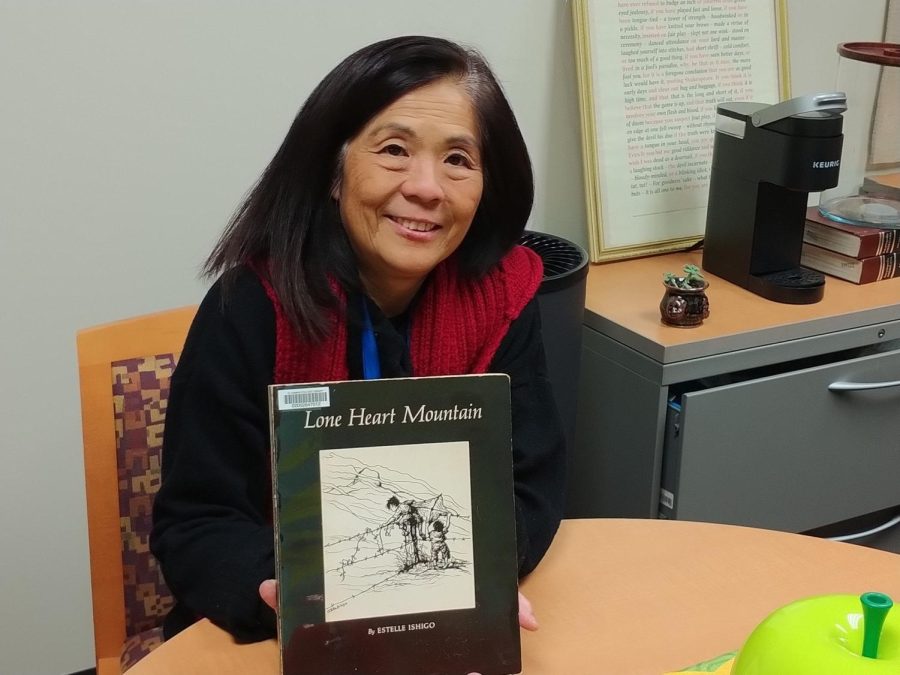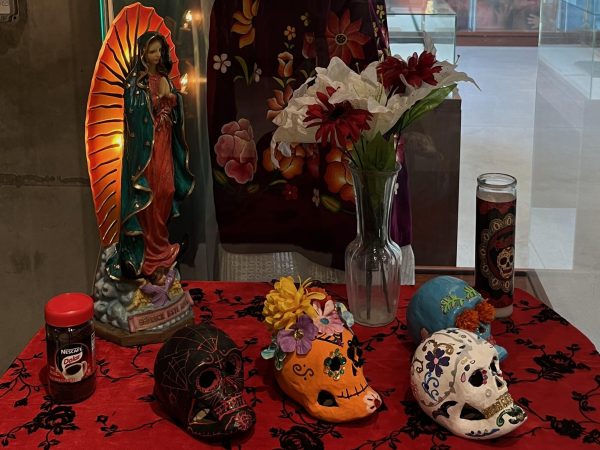‘Images: America’s concentration camps’ revisits the horror of Japanese incarceration
Assistant Director of the Learning Resources Center Sheryl Kunisaki holds “Lone Heart Mountain” by Estelle Ishigo. The book tells the story of her father-in-law Kenji Kunisaki having to go to Heart Mountain, one of the concentration camps on the West Coast during World War II. The book is on display and can be checked out at the Library. (Anthony Lipari | The Union)
Update: The headline and story content has been updated to provide additional details for clarification.
A young girl stands behind barbed wire.
Behind her, mountains lined with greenery fill the background.
In between, hundreds of people looked in all directions with watchtowers peeking high above them.
The girl in the artwork, entitled “Segregated,” is Ruby Mochidome.
She was at the Rohwer Ark concentration camp as a result of executive policy enacted by the Roosevelt administration which led to the incarceration of all people deemed a threat to national security on the West Coast inland.
Executive Order 9066 was signed on Feb. 19, 1942, it ordered all people of Japanese ancestry, most of whom were U.S. citizens, to be removed and put into concentration camps.
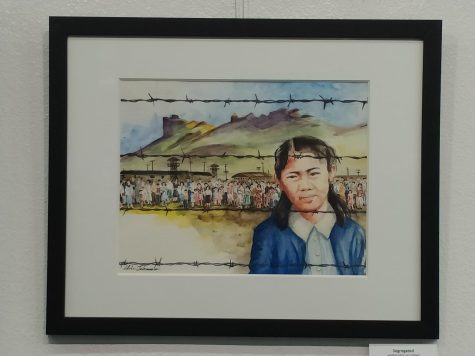
“Images: America’s Concentration Camps,” commemorates the 80th anniversary of the signing of Executive Order 9066. The exhibit is currently open in Schauerman Library and will conclude on Dec. 9.
Ruby’s daughter, Debra Mochidome is an English as a second language professor and the organizer of the exhibit. She said that the impact incarceration had on Japanese-American citizens is important for people to understand and remember.
“It’s important for us to remember that this is, sadly, a part of American history that’s really dark,” Mochidome said. “We have to be really vigilant…so that this type of thing doesn’t happen ever again.”
Mochidome also said that the separation and imprisonment of immigrant families remains an ongoing problem as many immigrant families from Central America and other areas of the world are being incarcerated.
The exhibit features artwork from many people, including pieces from Mochidome’s husband and retired history professor at California State University Dominguez Hills Donald Hata. His late wife, Nadine Ishitani, was formerly the vice president of Academic Affairs at the college.
The exhibit also has a bookshelf with novels about Japanese American internment during World War II. Assistant Director of the Learning Resources Center Sheryl Kunisaki said her father-in-law is in “Lone Heart Mountain,” by Estelle Ishigo, one of the books on display.
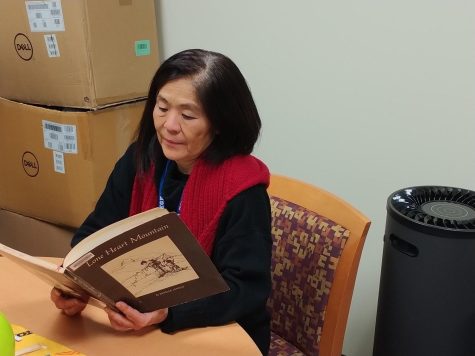
Kunisaki’s father-in-law, Kenji Kunisaki, was forced to leave for Heart Mountain, one of America’s concentration camps. He was not even allowed to bring his dog, so he had to put his faithful companion to sleep.
According to page five of “Lone Heart Mountain,”: “They paid the bill, then carried their faithful pet home and laid him in a little grave under a tree while Kenji watched with wide, dry eyes with questions none could answer.”
Kenji remembers a white woman at the camp, who was with her husband. That lady was Estelle Ishigo.
Ishigo had no children, however, she would invite them to her barracks for snacks. One of the snacks was “sembei,” a Japanese rice cracker.
“For some reason, she had access to good snacks,” Kunisaki said.
Kunisaki said her favorite art piece was “Remembering… To Prevent History from Repeating” by Alvin Takamori. The artwork is about the annual Manzanar Pilgrimage, an event filled with memorial services, speakers, and cultural performances.
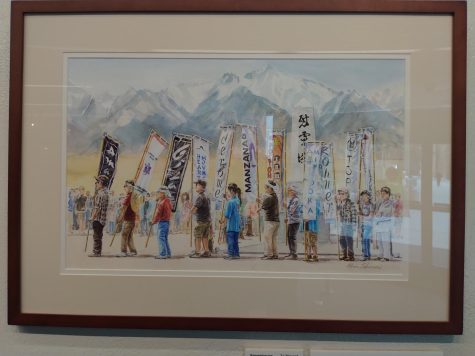
“I was not forced by our government to leave my home but my family members all were,” Kunisaki said. “So I feel I’m a part of the collective responsibility to share with others what happened to Japanese Americans during World War II.”
The artwork features banners of the 10 concentration camps on the West Coast, including Manzanar and Heart Mountain. Hundreds of people gather to watch the pilgrimage and behind the audience are mountains that stretch beyond the clouds.
Outreach Librarian Camila Jenkin is the coordinator of exhibits like this one in the library. She said that her favorite part about the exhibit was not just the artwork, but the people she met who are featured in the exhibit.
“The people whose family members are portrayed here, they stood in our lobby,” Jenkin said. “That’s pretty wild.”
Editor’s Note: Updated story to provide more context on Japanese and Central American incarceration on Nov. 15, 2022, at 1:41 p.m.


